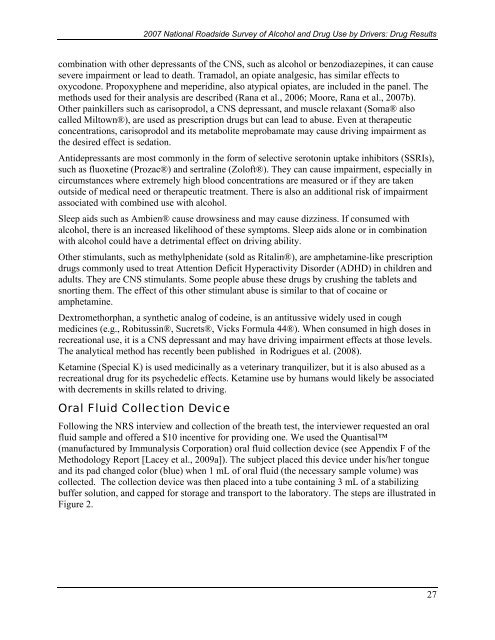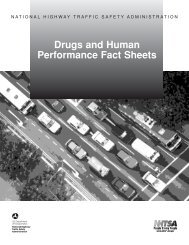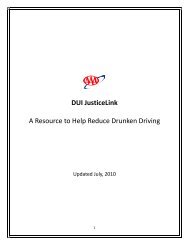<strong>2007</strong> <strong>National</strong> <strong>Roadside</strong> <strong>Survey</strong> <strong>of</strong> <strong>Alcohol</strong> <strong>and</strong> <strong>Drug</strong> <strong>Use</strong> <strong>by</strong> <strong>Drivers</strong>: <strong>Drug</strong> ResultsAmphetamines are CNS stimulants <strong>and</strong> are used both medicinally <strong>and</strong> as drugs <strong>of</strong> abuse.Amphetamines are generally taken recreationally <strong>and</strong> to enhance performance (e.g., truck driversstaying awake). Ecstasy falls within this category, <strong>and</strong> as a methylated amphetamine derivative italso has hallucinogenic properties. Amphetamines have been associated with crash occurrence<strong>and</strong> could logically be associated with driving impairment both in the stimulation <strong>and</strong> withdrawalstages; in the latter case especially as the drug interacts with fatigue. The analytical methodologyis described in an article <strong>by</strong> Moore, Coulter, <strong>and</strong> Crompton (<strong>2007</strong>).Cannabinoids have a variety <strong>of</strong> effects on humans <strong>and</strong> can be associated with stimulant, sedative,<strong>and</strong> hallucinogenic effects. Both the experimental <strong>and</strong> epidemiologic evidence on cannabinoids’effects on driving are mixed. When marijuana is found in drivers, however, it is <strong>of</strong>ten inconjunction with alcohol, where an impairing effect is more likely. The most prevalent drugdetected in the pilot study was marijuana (Lacey et al., <strong>2007</strong>). There appeared to be a strongpositive correlation between the oral fluid <strong>and</strong> blood tests, <strong>and</strong> the only discrepancies found inthe pilot study (negative oral fluid <strong>and</strong> a positive blood) were from 10 cases in which the inactivemetabolites were detected in blood but not the active tetrahydrocannabinol (THC). A positivemetabolite result (THCA) with a negative parent compound (THC) is consistent with less recentuse (e.g., in the days before sample was taken). A positive oral fluid for the parent compound islikely to be associated with very recent THC use, the timeframe consistent with potentialimpairing effects. Thus, such oral fluid results can be very informative. The laboratoryprocedures for testing the oral fluid results have been previously published in several articles(Moore et al., 2006; Moore, Rana, & Coulter, <strong>2007</strong>c; Coulter, Miller, Crompton, & Moore,2008).Phencyclidine (PCP) is related to veterinary tranquilizers such as ketamine, that impair motorability, but it also has hallucinogenic effects <strong>and</strong> is used as a recreational drug. PCP has seriousperformance diminishing effects <strong>and</strong> has been found in impaired-driving cases. Its determinationin oral fluid has recently been published in Coulter, Crompton, <strong>and</strong> Moore (2008).Benzodiazepines include many widely prescribed drugs (e.g., Valium®, Xanax®) to reduceanxiety. These drugs act as CNS depressants, show cross-tolerance to ethanol, <strong>and</strong> are potentiallyassociated with driver impairment. Different types <strong>of</strong> benzodiazepines have very short to verylong half-lives. For example, the desired/therapeutic effect <strong>of</strong> lorazepam (Ativan®) is sedation,which would obviously have a detrimental effect on driving a motor vehicle. The most commonbenzodiazepine is diazepam (Valium®) <strong>and</strong>/or its metabolites: nordiazepam, oxazepam, <strong>and</strong>temazepam. The confirmation procedure for the <strong>2007</strong> study included LC/MS/MS confirmationusing the method described in Moore, Coulter, Crompton, <strong>and</strong> Zumwalt (<strong>2007</strong>).Barbiturates are still widely prescribed CNS depressants <strong>and</strong> in some cases as anti-epilepticmedications. Because <strong>of</strong> their depressive effects, barbiturates are associated with delayedreaction times <strong>and</strong> possibly loss <strong>of</strong> concentration; both effects likely to affect drivingperformance.Methadone, a narcotic analgesic, is used both medicinally for opiate detoxification <strong>and</strong>maintenance, <strong>and</strong> for pain relief. It has also been used as a drug <strong>of</strong> abuse. It may have differentialperformance effects in naïve or recreational users versus tolerant therapeutic users, <strong>and</strong> certainlydeserves study.Painkillers are a class <strong>of</strong> drugs that may lead to driving impairment. Commonly used painkillersinclude oxycodone (an opioid). Oxycodone has similar effects to morphine <strong>and</strong> heroin. If used in26
<strong>2007</strong> <strong>National</strong> <strong>Roadside</strong> <strong>Survey</strong> <strong>of</strong> <strong>Alcohol</strong> <strong>and</strong> <strong>Drug</strong> <strong>Use</strong> <strong>by</strong> <strong>Drivers</strong>: <strong>Drug</strong> Resultscombination with other depressants <strong>of</strong> the CNS, such as alcohol or benzodiazepines, it can causesevere impairment or lead to death. Tramadol, an opiate analgesic, has similar effects tooxycodone. Propoxyphene <strong>and</strong> meperidine, also atypical opiates, are included in the panel. Themethods used for their analysis are described (Rana et al., 2006; Moore, Rana et al., <strong>2007</strong>b).Other painkillers such as carisoprodol, a CNS depressant, <strong>and</strong> muscle relaxant (Soma® alsocalled Miltown®), are used as prescription drugs but can lead to abuse. Even at therapeuticconcentrations, carisoprodol <strong>and</strong> its metabolite meprobamate may cause driving impairment asthe desired effect is sedation.Antidepressants are most commonly in the form <strong>of</strong> selective serotonin uptake inhibitors (SSRIs),such as fluoxetine (Prozac®) <strong>and</strong> sertraline (Zol<strong>of</strong>t®). They can cause impairment, especially incircumstances where extremely high blood concentrations are measured or if they are takenoutside <strong>of</strong> medical need or therapeutic treatment. There is also an additional risk <strong>of</strong> impairmentassociated with combined use with alcohol.Sleep aids such as Ambien® cause drowsiness <strong>and</strong> may cause dizziness. If consumed withalcohol, there is an increased likelihood <strong>of</strong> these symptoms. Sleep aids alone or in combinationwith alcohol could have a detrimental effect on driving ability.Other stimulants, such as methylphenidate (sold as Ritalin®), are amphetamine-like prescriptiondrugs commonly used to treat Attention Deficit Hyperactivity Disorder (ADHD) in children <strong>and</strong>adults. They are CNS stimulants. Some people abuse these drugs <strong>by</strong> crushing the tablets <strong>and</strong>snorting them. The effect <strong>of</strong> this other stimulant abuse is similar to that <strong>of</strong> cocaine oramphetamine.Dextromethorphan, a synthetic analog <strong>of</strong> codeine, is an antitussive widely used in coughmedicines (e.g., Robitussin®, Sucrets®, Vicks Formula 44®). When consumed in high doses inrecreational use, it is a CNS depressant <strong>and</strong> may have driving impairment effects at those levels.The analytical method has recently been published in Rodrigues et al. (2008).Ketamine (Special K) is used medicinally as a veterinary tranquilizer, but it is also abused as arecreational drug for its psychedelic effects. Ketamine use <strong>by</strong> humans would likely be associatedwith decrements in skills related to driving.Oral Fluid Collection DeviceFollowing the NRS interview <strong>and</strong> collection <strong>of</strong> the breath test, the interviewer requested an oralfluid sample <strong>and</strong> <strong>of</strong>fered a $10 incentive for providing one. We used the Quantisal(manufactured <strong>by</strong> Immunalysis Corporation) oral fluid collection device (see Appendix F <strong>of</strong> theMethodology Report [Lacey et al., 2009a]). The subject placed this device under his/her tongue<strong>and</strong> its pad changed color (blue) when 1 mL <strong>of</strong> oral fluid (the necessary sample volume) wascollected. The collection device was then placed into a tube containing 3 mL <strong>of</strong> a stabilizingbuffer solution, <strong>and</strong> capped for storage <strong>and</strong> transport to the laboratory. The steps are illustrated inFigure 2.27




